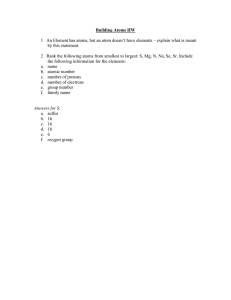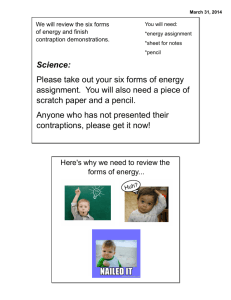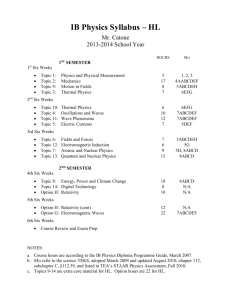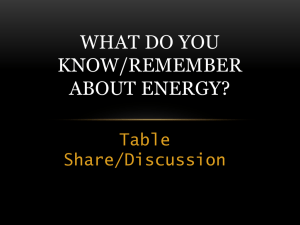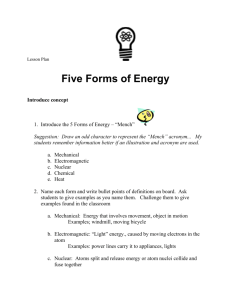Forms of Energy Resource Packet
advertisement
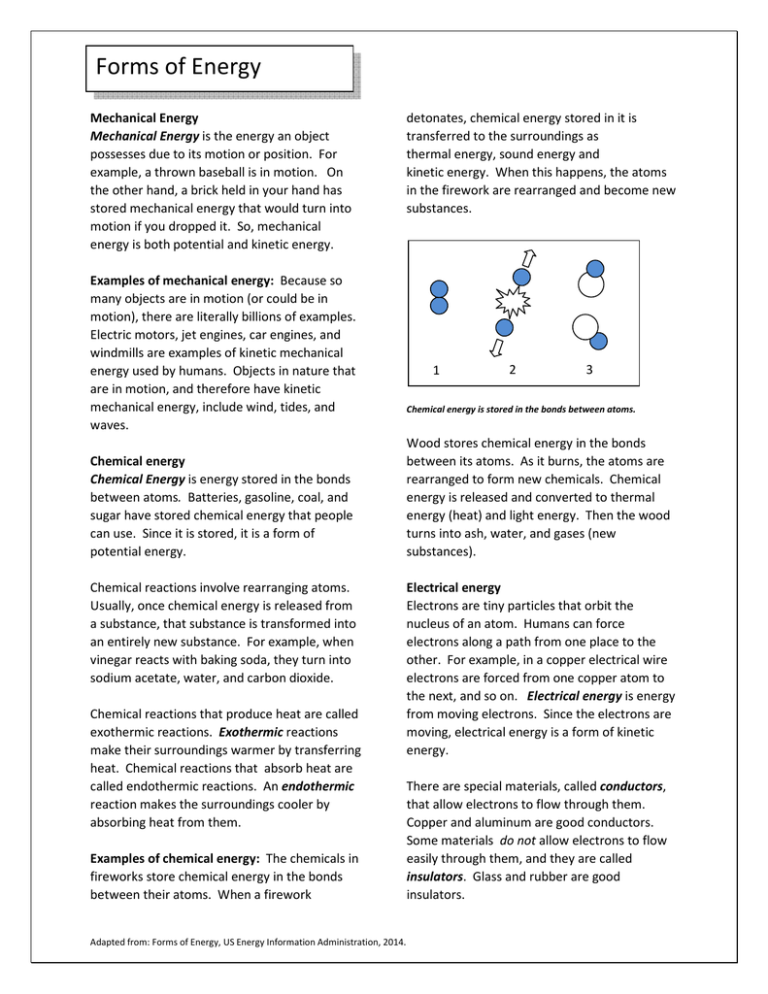
Forms of Energy Mechanical Energy Mechanical Energy is the energy an object possesses due to its motion or position. For example, a thrown baseball is in motion. On the other hand, a brick held in your hand has stored mechanical energy that would turn into motion if you dropped it. So, mechanical energy is both potential and kinetic energy. Examples of mechanical energy: Because so many objects are in motion (or could be in motion), there are literally billions of examples. Electric motors, jet engines, car engines, and windmills are examples of kinetic mechanical energy used by humans. Objects in nature that are in motion, and therefore have kinetic mechanical energy, include wind, tides, and waves. Chemical energy Chemical Energy is energy stored in the bonds between atoms. Batteries, gasoline, coal, and sugar have stored chemical energy that people can use. Since it is stored, it is a form of potential energy. Chemical reactions involve rearranging atoms. Usually, once chemical energy is released from a substance, that substance is transformed into an entirely new substance. For example, when vinegar reacts with baking soda, they turn into sodium acetate, water, and carbon dioxide. Chemical reactions that produce heat are called exothermic reactions. Exothermic reactions make their surroundings warmer by transferring heat. Chemical reactions that absorb heat are called endothermic reactions. An endothermic reaction makes the surroundings cooler by absorbing heat from them. Examples of chemical energy: The chemicals in fireworks store chemical energy in the bonds between their atoms. When a firework Adapted from: Forms of Energy, US Energy Information Administration, 2014. detonates, chemical energy stored in it is transferred to the surroundings as thermal energy, sound energy and kinetic energy. When this happens, the atoms in the firework are rearranged and become new substances. 1 2 3 Chemical energy is stored in the bonds between atoms. Wood stores chemical energy in the bonds between its atoms. As it burns, the atoms are rearranged to form new chemicals. Chemical energy is released and converted to thermal energy (heat) and light energy. Then the wood turns into ash, water, and gases (new substances). Electrical energy Electrons are tiny particles that orbit the nucleus of an atom. Humans can force electrons along a path from one place to the other. For example, in a copper electrical wire electrons are forced from one copper atom to the next, and so on. Electrical energy is energy from moving electrons. Since the electrons are moving, electrical energy is a form of kinetic energy. There are special materials, called conductors, that allow electrons to flow through them. Copper and aluminum are good conductors. Some materials do not allow electrons to flow easily through them, and they are called insulators. Glass and rubber are good insulators. An electrical current occurs when electrons are pushed, sort of like the current of a stream pushes a floating stick. The current forces electrons to move through a wire until they reach an electrical appliance like a light bulb. because it is so much larger than a cup of coffee. Therefore, temperature is simply how hot or cold an object is, measured in degrees. Heat is the transfer of thermal energy from one object to another. Electrical current "pushes" electrons from atom to atom in a Examples of thermal energy: Heat always flows from hotter objects to cooler ones. If you hold a warm penny, thermal energy will flow from the penny to your hand. The atoms in the penny would start to vibrate more slowly, and the atoms in your skin would start to vibrate more quickly. Thermal energy would continue to flow from then penny to your hand until both your hand and the penny were the same temperature. copper wire Examples of electrical energy: Electrical energy is formed when chemical energy from a battery is used to push electrons along a copper wire. When the electrical energy reaches a light bulb, it is transformed into radiant energy (light) and thermal energy (heat). In the same way, electrical energy travelling through a wire in your house to a blender is transformed into motion energy, thermal energy (heat), and sound energy. Thermal Energy Matter is made up of atoms. These atoms move (or vibrate) constantly. Atoms vibrate faster in hot objects and slower in cold objects. Thermal energy is energy from vibrating atoms. The hotter the substance, the more its molecules vibrate, and the therefore efore the higher its thermal energy. Since thermal energy involves atoms in motion, it is a form of kinetic energy. There is a difference between heat and temperature. Think about a cup of water and a swimming pool. They may both have a temperature of 78o Fahrenheit, but obviously the swimming pool has much more energy Adapted from: Forms of Energy, US Energy Information Administration, 2014. Thermal energy flows from a light bulb to the air in the room. When the light bulb is turned off, the thermal energy continues ntinues to flow until the light bulb is the same temperature as the air. Then it no longer feels warm. Electromagnetic energy Electromagnetic energy is emitted from objects as waves. Forms of electromagnetic energy include radio waves, microwaves, visible light, and x-rays. Electromagnetic waves travel at the speed of light, which is 186,000 miles per second. Therefore, a radio wave could circle the Earth almost eight times in one second, and light travels 93 million miles from the Sun to the Earth in only nine minutes. Because electromagnetic waves are moving, they are a form of kinetic energy. Electromagnetic energy can travel through the air, solids, and liquids. In addition, electromagnetic energy can travel through space. If it couldn't , sunlight would never reach the Earth! Examples of electromagnetic energy: Microwaves are the shortest electromagnetic waves. They bounce around inside the microwave, causing water molecules in the food to start vibrating billions of time each second, transforming the electromagnetic energy into heat energy. Radar waves 1) are emitted by the radar transmitter, 2) reflect off of the aircraft, and 3) travel back to the radar receiver. Radar waves are energy that is emitted from a special transmitter. The radar waves reflect off objects, and the reflected waves travel back to the receiver. Nuclear Energy Nuclear energy is energy stored in the nucleus, or center, of atoms. Because nuclear energy is stored energy it is a form of potential energy. During nuclear fission, atoms are split apart to form new elements. In nuclear fusion, atoms are fused together to form a new element. Both processes release tremendous amounts of energy. An example of nuclear energy: In a nuclear reactor, atoms of uranium are split and become atoms of barium and krypton. This releases tremendous amounts of energy. Heat released during nuclear fission is used to turn water into steam to run electrical generators. Uranium fission Adapted from: Forms of Energy, US Energy Information Administration, 2014.

